
Procellariiformes is an order of seabirds that comprises four families: the albatrosses, petrels and shearwaters, and 2 families of storm petrels. Formerly called Tubinares and still called tubenoses in English, procellariiforms are often referred to collectively as the petrels, a term that has been applied to all members of the order, or more commonly all the families except the albatrosses. They are almost exclusively pelagic, and have a cosmopolitan distribution across the world's oceans, with the highest diversity being around New Zealand.

Seabirds are birds that are adapted to life within the marine environment. While seabirds vary greatly in lifestyle, behaviour and physiology, they often exhibit striking convergent evolution, as the same environmental problems and feeding niches have resulted in similar adaptations. The first seabirds evolved in the Cretaceous period, and modern seabird families emerged in the Paleogene.

Northern storm petrels are seabirds in the family Hydrobatidae, part of the order Procellariiformes. The family was once lumped with the similar austral storm petrels in the combined storm petrels, but have been split, as they were not closely related. These smallest of seabirds feed on planktonic crustaceans and small fish picked from the surface, typically while hovering. Their flight is fluttering and sometimes bat-like.

The European storm petrel, British storm petrel, or just storm petrel is a seabird in the northern storm petrel family, Hydrobatidae. It is the only member of the genus Hydrobates. The small, square-tailed bird is entirely black except for a broad, white rump and a white band on the under wings, and it has a fluttering, bat-like flight. The large majority of the population breeds on islands off the coasts of Europe, with the greatest numbers in the Faroe Islands, United Kingdom, Ireland, and Iceland. The Mediterranean population is a separate subspecies, but is inseparable at sea from its Atlantic relatives; its strongholds are Filfla Island (Malta), Sicily, and the Balearic Islands.
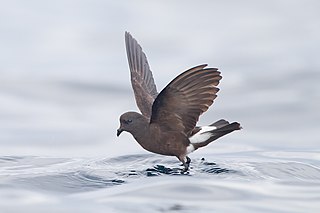
Wilson's storm petrel, also known as Wilson's petrel, is a small seabird of the austral storm petrel family Oceanitidae. It is one of the most abundant bird species in the world and has a circumpolar distribution mainly in the seas of the southern hemisphere but extending northwards during the summer of the northern hemisphere. The world population has been estimated to be more than 50 million pairs. The name commemorates the Scottish-American ornithologist Alexander Wilson. The genus name Oceanites refers to the mythical Oceanids, the three thousand daughters of Tethys. The species name is from Latin oceanus, "ocean".
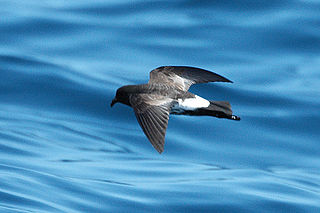
The New Zealand storm petrel is a small seabird of the family Oceanitidae. Thought to be extinct since 1850, a series of sightings from 2003 to the present indicates the presence of a previously unknown colony. As of 2010, it is ranked on the IUCN Red List as critically endangered.

Hornby's storm petrel, also known as the ringed storm petrel, is a seabird that ranges in the Humboldt Current off the coasts of South America. The species is a very distinctive member of the storm petrel family, with a dark cap, white face and underparts, forked tail and a black band across the chest. It is relatively common in the seas off Peru, Chile and Ecuador. The species is named after Admiral Sir Phipps Hornby.
The Isles of Scilly Wildlife Trust, formed in 1985, is a Wildlife Trust covering the Isles of Scilly, a group of islands off the coast of Cornwall. It became the 46th member of The Wildlife Trusts in 2001 and is dedicated to ensuring that the archaeological and historical remains on the islands, as well as the flora and fauna, are protected and maintained.

The white-bellied storm petrel is a species of seabird in the family Oceanitidae. It is found in Angola, Argentina, Australia, Brazil, Chile, Ecuador, French Polynesia, French Southern Territories, Maldives, Namibia, New Zealand, Perú, Saint Helena, and South Africa. Its natural habitat is open seas.

Oceanites is a genus of seabird in the austral storm petrel family. The genus name refers to the mythical Oceanids, the three thousand daughters of Tethys.

Markham's storm petrel is a species of storm petrel in the family Hydrobatidae. An all black to sooty brown seabird, Markham's storm petrel is difficult to differentiate from the black petrel Procellaria parkinsoni in life, and was once described as conspecific with, or biologically identical to, Tristram's storm petrel Oceanodroma tristrami. Markham's storm petrel inhabits open seas in the Pacific Ocean around Peru, Chile, and Ecuador, but only nests in northern Chile and Peru, with ninety-five percent of all known breeding populations in 2019 found in the Atacama Desert. First described by British ornithologist Osbert Salvin in 1883, the bird was named in honor of Albert Hastings Markham, a naval officer who collected a specimen off Peru.
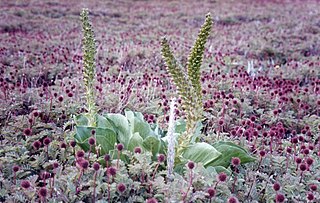
The Southern Indian Ocean Islands tundra is a tundra ecoregion that includes several subantarctic islands in the southern Indian Ocean.

Austral storm petrels, or southern storm petrels, are seabirds in the family Oceanitidae, part of the order Procellariiformes. These smallest of seabirds feed on planktonic crustaceans and small fish picked from the surface, typically while hovering. Their flight is fluttering and sometimes bat-like.

Hydrobatinae is one of two subfamilies of storm petrels. The distribution of the subfamily is predominantly in the northern hemisphere. The subfamily contains two genera in which there are 18 species. They were the first group of storm petrels to break off from the ancestral petrel stock, and for this reason some authors have suggested that they should constitute a separate family from the Oceanitinae storm petrels.
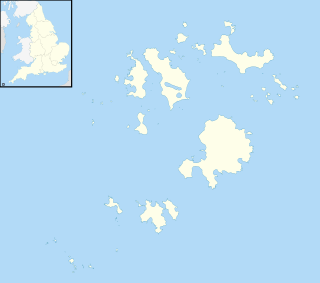
The Western Rocks are a group of uninhabited skerries and rocks in the south–western part of the Isles of Scilly, United Kingdom, and are renowned for the numerous shipwrecks in the area and the nearby Bishop Rock lighthouse. In 1971, the rocks and islands were designated a Site of Special Scientific Interest for their breeding sea birds. Landing on the islands is both difficult and discouraged and there are few published records of visits by naturalists.
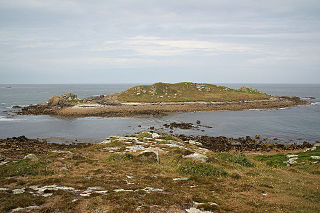
The Norrard (Northern) Rocks are a group of small uninhabited granite rocks in the north–western part of the Isles of Scilly, to the west of Bryher and Samson. In 1971 they were designated as a Site of Special Scientific Interest (SSSI) for their breeding seabird colonies and they are permanently closed to landings from boat passengers. The vegetation on the islands is limited by the extreme exposure and only six species of flowering plants have been recorded.
Philoceanus robertsi is a species of phtilopterid louse found on seabirds including European storm petrel and Wilson's storm petrel.
Alderney Bird Observatory is a bird observatory on the island of Alderney, in the Channel Islands. It was setup in March 2016, with the logistical support of the Alderney Wildlife Trust to study bird migration and the island's seabird colonies. Progressed to become and independent company 'Alderney Bird Obervatory Ltd' in April 2019, a Channel Islands registered company and charity. Became the 20th accredited bird observatory in the Biritsh Isles at a recent meeting of the Bird Observatories Council. The first observatory was Skokholm, Pembrokeshire, Wales which opened in 1933.












